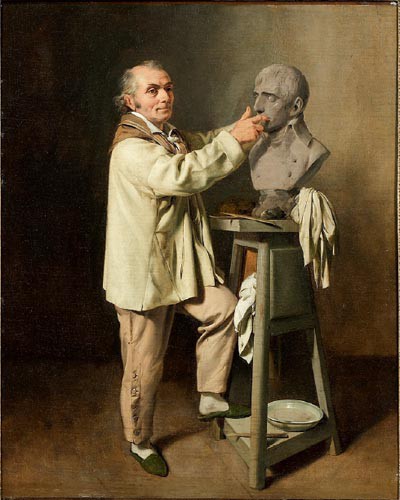This canvas is one of a series of preparatory studies that Boilly carried out in preparation for L’Atelier d’un sculpteur. Tableau de Famille. The painting, better known today as L’Atelier de Houdon, was unveiled at the Salon of 1804 and is today held in the Musée des Arts décoratifs in Paris. This particular work, completed between 1802 and 1803, reveals a great deal about the artist’s journey towards the completed article that would be displayed in 1804. Although the central character remains the same – Houdon at work in his studio – the secondary element, in this case the half-formed bust of Bonaparte, would eventually be replaced by that of the astronomer and mathematician, Pierre-Simon de Laplace (1749-1827). Another preparatory version, held at the Musée des Beaux-Arts in Lille, is almost an exact replica of this painting, with one exception: Bonaparte has already been replaced by Laplace. The mathematician himself can be seen in the final composition, sat in his chair – which has been placed on a platform – and modelling for the sculptor. The scene includes Houdon’s wife and three daughters, and takes place in the artist’s studio, in the Palais des Beaux-Arts – the former Collège des Quatre-Nations which would later (in 1805) become the Institut de France’s headquarters.
Boilly eventually chose not to include the First Consul in the final version of the painting, but we still have this study, an intimate and realistic snapshot of a sculptor busy in his studio. Every detail, mundane or otherwise, is left in. The artist is depicted at work, dressed in slippers and a simple smock. The scene is bare, with only Houdon’s tools, chisels and spatulas for decoration. The bust of Bonaparte sits on a small turntable, the clay kept moist with damp cloths and water from a basin on the stand. The painting also sheds light on the Bonaparte bust, today lost, but which features in an auction catalogue compiled after the sculptor’s death in 1828. Although very little is known about the conception or creation of the original bust, a number of marble reproductions – which resemble effigies of Boizot from the same period – still remain. None is signed, suggesting that Houdon was dissatisfied with the result. His second portrait of Napoleon, executed in 1806, has however remained with us: the famous terracotta “Napoleon as Hermes” bust, now held in the Musée des Beaux-Arts in Dijon, is notable for the sittings at Saint-Cloud that Napoleon accorded Houdon, a rare privilege indeed.
Karine Huguenaud (tr. H.D.W.)
January 2012


